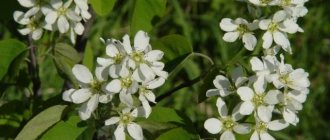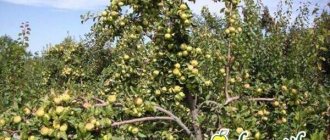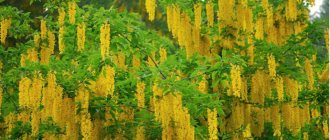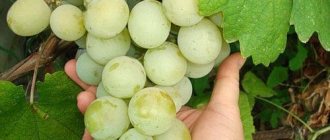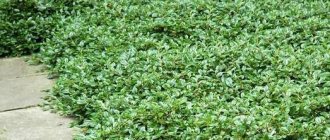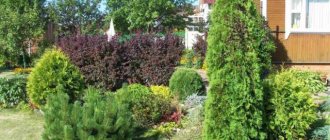Encyclopedia of Plants
Maiden grape (Parthenocissus) is a deciduous shrub, commonly known as virginiana. Belongs to the Vinogradov family, which has more than ten different species. The historical homeland of the plant is considered to be Asian territories and the northern parts of America. However, since ancient times, the plant has been used everywhere in countries with temperate climates.
- 1 Description of the plant
- 2 Varieties of wild grapes
- 3 Maiden grapes: planting and care 3.1 Propagation of grapes
- 3.2 Propagation of virgin grapes by cuttings
- 3.3 Caring for grapes
Maiden grape five-leaf (five-leaved) - characteristics
The shrub comes from the American continent. The plant was introduced into cultivation in Europe in 1629. The liana easily climbs various types of vertical supports. Numerous long stems, clinging to supports, and complex leaves form a dense green carpet, attractive throughout the entire growing season. In autumn, the leaves take on fabulous colors, intense shades of red and purple.
a brief description of
- Plant group: lianas.
- Plant subgroup: ornamental foliage, fruits.
- Height: 10-20 m.
- Decorative parts: leaves, fruits.
- Fruits: berries.
- Fruit color: dark blue.
- Duration of landscaping: seasonal.
- Soil: the plant is undemanding to soil conditions.
- Optimal soil pH: neutral.
- Position: Well-lit areas.
- Use for landscaping: balconies, gardens, parks, fences, urban landscaping.
Appearance
How quickly do ornamental grapes grow? The girlish five-leaf climbing grape annually grows 1-2 meters in length and grows up to 10-20 meters in height. The remarkable beauty of the climbing plant is due to its strong tendrils, which have 5-12 suckers at the ends. Suckers firmly attach to various types of surfaces on which other vines have no chance to gain a foothold. The mustache will not cope with glass or marble, but will conquer other surfaces:
- all types of plaster,
- stone,
- brick,
- tree.
The main decoration of the vine is its fairly large leaves, consisting of 5 leaflets located on a long petiole. Leaf blades are green, shiny, red in autumn. The peculiar arrangement of the leaves of the plant provides protection for the walls of buildings on which the vines are located from:
- rain,
- wind,
- sun.
Hidden under the leaves, inconspicuous flowers bloom in June. Later, beautiful purple fruits appear, with an average size of 5 mm. The fruits are located on decorative red stems, not very noticeable among the leaves during the growing season. After the first frost, when the leaves fall, the fruits appear in all their glory, decorating the bare stems until December, unless birds notice them. In winter, grape berries become a delicacy for blackbirds.
Varieties
- Tripointed maiden grape (Parthenocissus tricuspidata) - has highly developed mustaches that make it easier to climb vertical surfaces, used to fill walls. Young leaves are green and gradually turn purple. A characteristic feature is tripointed leaves, reaching 10-20 cm in diameter. Tripoint grapes bloom at the turn of June – July.
- Five-leafed (Parthenocissus quinquefolia) - equipped with antennae with suckers, numerous shoots to facilitate climbing. The whiskers are not long, 5-8 suckers stick to the walls so strongly that they are difficult to separate from the wall. The leaves consist of 5 parts collected together and reach a length of 10 cm. Young shoots are colored red, green leaves undergo autumn bleaching to purple-red. The berries are dark blue (almost black), inedible.
- Attached (Parthenocissus vitacea) - the plant resembles a five-leaf plant, but grows more slowly. The antennae wrap around the support; there are no suction cups. The leaves turn green in summer and turn red in autumn. The species is resistant to frost and pests, and is used for planting gazebos and supports. The berries are inedible for humans.
A little about the varieties
Despite the fact that the Maiden grape is a foreign plant, on our continent it can be found literally at every step.
This vine, if not treated correctly, can, like hops, weave everything around and kill other plants nearby.
Therefore, not every gardener will decide to purposefully plant it on his plot.
Soon you won't even be able to see the windows in your house.
Previously, this grape was called wild, and sometimes they even fought it like a weed. But selection as a science also does not stand still.
Now there are varieties with a tamed “temper” and incredibly beautiful colors (and not only red), which have made planting an ornamental vineyard a popular means for creating an interesting home landscape.
How can you not appreciate such beauty?
We present the best grape varieties "Parthenocíssus quinquefolia". This is exactly what its name sounds like in Latin.
Star Showers
This variety was bred by American breeders. It is not immediately possible to recognize the familiar wild grapes in it.
It is distinguished by its unusual variegated colors, as if the leaves were painted by some avant-garde artist.
In the summer heat, the strokes on them are yellow-green, and with the onset of lower autumn temperatures, red-pink tones appear in the color of the foliage.
Starfall variety
The leaf blade of Starfall is smaller than that of the common Parthenocíssus. It has a slightly different shape: the tips are completely separated from each other and touch only at the cutting.
Thanks to this structure of the leaves, the vine looks more weightless, almost openwork.
The flowers of this plant are unremarkable, like all other varieties of grapes. But the blue-black berries that appear in autumn look very picturesque against the backdrop of variegated leaves.
From a human point of view, the berries of this grape have no value, but for birds they are excellent food.
This variety does not grow as quickly and aggressively as its wild relative, and rarely grows above 8 meters even after a few years.
And regular cutting will help give the grapes the desired direction and keep the vines within the given limits. This plant is very well suited for planting near the walls of houses, gazebos, pergolas, and trellises.
Grape hedge
This variety is unlikely to survive the winter in Siberia, but is excellent for the middle zone. Only in the first year of growth does the plant need to be removed from its supports so that it can overwinter under the snow.
Next year you no longer need to do this. Having grown stronger, the vine will winter without problems. Even if the tips of the shoots freeze slightly, the vine does not react to this and regenerates quite quickly.
At certain intervals, ordinary shoots with green foliage appear on the grapes of this variety. They grow faster than variegated ones and, in order not to spoil the beautiful “image” of the plant, they need to be removed.
Red Wall (Troki)
A variety called Troki (Red Wall) was bred by breeders from Poland. In the spring, the newly opened leaves have a bronze tint, by summer they turn green, and in the fall they change their “outfit” to bright red. The leaf shape is five-fingered, the surface is glossy.
This variety climbs quite intensely, but not upward, but outwards. Therefore, the crown of the vineyard is quite dense. It can give a very thick coating. The berries that appear in the fall feed the birds all winter.
In spring:
Young foliage has a bronze tint
In summer:
In summer it turns green
Autumn:
In autumn it turns red and berries appear
The annual growth of the plant does not exceed 1.5 meters, and more often 1 m. Therefore, in 6 years, and sometimes even 10, the vine stretches no more than 7-8 meters.
Where to plant?
Five-leaved maiden vine is a beautiful ornamental vine, excellent for growing in urban areas and in summer cottages. It looks most beautiful in the fall, when the leaves turn from golden yellow, with hints of orange, to deep red, fading to deep burgundy.
The plant is ideal for:
- covering unsightly walls of outbuildings, sheds, garages;
- design of green walls, fences, gazebos;
- creating noise barriers.
Bushes planted at the foot of poles, lanterns, tree trunks with a high crown or on structures specially created for climbing plants, arbors and gates look very interesting. Indoors, wild grapes are successfully grown as a ground cover plant.
It can grow in any soil, but in fertile, moist soil it grows stronger and has dense foliage. The plant should be planted in a secluded, sunny or semi-shady position, but not near a south wall; growth is hampered by large temperature fluctuations between day and night.
Decorative girlish grapes, photo
Description of the plant
Maiden grape is a self-pollinating shrub. The leaves of the plant are dark green in color and consist of three or five leaves connected by one core. The edges of the foliage are variegated and may have an uneven, jagged appearance. The leaves are located on long single cuttings. A feature of the foliage is the ability to acquire a noble, rich red, brown color in the fall, which is often used for design purposes. The plant blooms in July with inconspicuous white, greenish flowers collected in a crown-shaped inflorescence. Depending on the variety, grape fruits can be blue, black, orange and even white. The berries are often inedible. The fruits remain on the vine after the leaves fall.
Lighting does not play a big role for the development of the plant; it develops well in the shade and in sunny space. The amount of sun rays only matters for the color of the foliage in the autumn season. If the plant is in the shade, its foliage may fall off without ever losing its green color. In bright sunshine, the foliage of the shrub takes on more colorful shades, which is especially appreciated in garden design.
Landing
Young plants are planted at least half a meter apart. When planting vines, ensure a distance of at least 30 cm from the walls. If trees or tall bushes are used as support, vines should be planted at a distance of about 1 meter from their base. Seedlings are planted in holes, which should preferably be filled with soil mixed with fertile soil or organic fertilizers, such as compost. This planting significantly accelerates the growth and development of grapes.
How to make a trellis with your own hands according to the scheme: from metal, pipes, wood
For good development and fruiting of the vineyard, it is necessary to constantly care for it. Also, grape plants need strong support that will hold the vines and ripening bunches. Trellis, pergolas, trellises, arches are made from various materials:
- tree;
- metal;
- plastic pipes.
Supports for grapes are classified according to several criteria:
- single-plane. The simplest type of grape supports. Making them will not take much time and money spent if everything is made from scrap materials. To do this, you will need wooden, metal or reinforced concrete posts dug into the ground, between which wire is stretched in one plane, in several rows;
- two-plane. Supports that have two flat frames connected into one structure. To make them you will need 2.5 m metal pipes, wire, cement with sand and crushed stone. A rectangle 3 meters long and 80 cm wide is marked with pegs. At the marking site, four holes 0.5 m deep are dug. Metal pipes are placed in them at such an angle to form the English letter V. The width at the bottom should be 80 mm at the top. The pipes are then filled with concrete. After complete hardening, the wire is stretched along the pillars. The first tier is 50 cm from the ground, the distance between the next ones should be about 40 cm;
- pergolas, trellises and other decorative supports. What such a structure will look like, and what it will be made of, everyone must choose for themselves. Guided by your preferences and availability of materials.
It is necessary to secure the pipes as best as possible so that they do not tilt under the weight of the future harvest.
Growing and care
Liana has no special requirements for cultivation:
- grows in the vast majority of soils;
- not afraid of drought;
- withstands shading in summer;
- withstands severe frost in winter;
- plants planted with southern exposure bear fruit abundantly and are more intensely colored in autumn;
- not sick;
- not attacked by pests.
The liana is characterized by strong growth and can quickly turn a fence into a beautiful green wall. If you notice that individual specimens are growing slowly, you can replace them with new plants during the growing season. Seedlings should be purchased in containers.
Trimming
Immediately after planting, the shoots are cut to 3-4 eyes. In subsequent years, each season at the beginning of spring, about 1/3 of the last growth is cut off. Shortening shoots can be done in the summer, no later than the end of July, so that the shoots growing after pruning have time to become woody before the onset of winter.
Watering, fertilizing
Sufficient soil moisture should be ensured during the period of rapid growth of wild grapes. Lack of water in the soil can significantly reduce vine growth.
The application of organic fertilizers allows:
- increase soil moisture capacity;
- allows for less frequent watering;
- provides grapes with nutrients;
- stimulates active growth and development.
Care, watering, fertilizing
Maiden grape is a very unpretentious tree-like vine; in open ground conditions, caring for it is quite simple, you just need to regularly and promptly carry out sanitary pruning of the vines and water it in severe drought. Without pruning, this beautiful plant can turn into ugly thickets.
The most important thing is to formulate the culture in a timely manner
The first few years the liana actively increases its root mass; during this period it requires fertilizing with fertilizers twice during the growing season. You also need to tie up the young plant; in the future it will find support on its own, clinging with its tendrils and aerial roots to any roughness on the surface.
Strengthened virgin ivy will give an annual growth of several meters. To prevent the vine from entangling the entire area, let's figure out how to carry out the shaping.
Girlish grapes definitely need support
- Growing young shoots need to be guided along the support, thus forming the skeleton of the plant.
- Don’t be afraid to remove those shoots that don’t grow where you want them right away. This will not harm the vine.
- After the formation of the skeleton, only sanitary pruning is carried out in the spring and restraining pruning in the summer. All weak, damaged shoots are removed, as well as those that thicken the plant or give it a sloppy appearance.
Advice. When pruning shoots, leave no more than 5 mm above the bud, then you will save yourself from protruding stumps of lashes, which looks unsightly.
Slugs may appear on five-leafed maiden grapes
- Watering is carried out frequently during drought. The rest of the time, water is needed in moderate quantities - once a week. The root system of the crop is well developed, so water it abundantly so that the soil is saturated.
- Weed removal and soil loosening are carried out as necessary, although it should be noted that virgin grapes grow like a weed, so there is no need to worry too much about the looseness of the soil or weeds.
- Pruning is carried out several times a year if you need to shape the plant. If you want the vine to wrap around a building, a garter may be required.
- Fertilizers are mainly applied organic (compost, humus, ash, herbal infusions). It is best to do this in the summer, when the plant is suffering from heat, the rainy season or similar disasters. In the spring, if the vine does not grow at all, you can add 40 g of nitroammophoska to the soil.
- No winter preparation required. The crop is resistant to frost, and how can you cover a plant that has entwined a building, for example? But, if there are concerns, you can mulch the root zone with 25 cm of peat and cover the base of the maiden grapes. It would be enough.
Interesting!
Many vines react negatively to pruning, but not virgin grapes. This crop can not only be trimmed, but also shaped. This can be done throughout the summer.
Maiden grapes are practically not damaged by diseases and insects. Very rarely, if there are a lot of aphids in the garden, they can settle on this crop. Then you can treat it with “Aktara”, “Fufanon”, “Tanrek”, “Fitoverm”.
Girlish grapes are pleasing in appearance. This is a very beautiful crop with richly colored foliage. Coniferous crops, climbing roses and flowers like clematis get along best next to virgin grapes. It is believed that virgin grapes protect against noise and dust and improve the microclimate in the area. In the summer, entwining the building, the vine keeps the inside cool and fresh, and during the rainy season it protects from dampness and cold.
Watering for the crop may not be necessary, the exception may be a long drought. In case of unfavorable weather, the plant is watered three to four times per season in the morning or evening. Watering norm is two buckets for each bush. Once a year, the soil is loosened, weeds are removed, and the soil is mulched.
The rhizome of virgin grapes is prone to bareness. If this happens, you need to add fresh soil and lightly hill up the vine. The procedure is carried out in the fall, during the preparation of the garden plot for the winter cold.
During the season, sanitary pruning is carried out, damaged and dry shoots are removed, and those that need to be controlled from excessive growth.
Application
Maiden grapes, also called Japanese grapevines or Veitch varieties, are the most showy of the "loaches." It is grown near high-rise buildings in cities, hiding the shortcomings and highlighting the advantages of old buildings. The shoots are distributed evenly along the walls, fan-shaped. Particularly suitable for covering various types of walls, planted next to a brick, metal, stone fence. The compact leaves are placed on the fence in a tile pattern, overlapping each other. The plant is attached using Velcro at the end of the tendrils. Dense foliage effectively stops dust and suppresses noise.
Types and description of grape supports: gazebo, canopy, pergolas
Grapes are a perennial plant. From about two to three years of age, he needs strong, reliable support. The support consists of concrete, wooden or metal stakes driven vertically into the ground, with wire stretched between them at a distance of 25–40 cm from each other. For fruit-bearing grapes growing on a personal plot, from which you only plan to collect fruits and do not perform a decorative function, it is enough to make the simplest straight columnar support. If the vineyard will also serve as a decorative element, a canopy from the sun, or a wall protecting the area from prying eyes, more complex structures will be required. Let's look at some of them.
Pergolas for vines
A pergola is a structure of arches connected to each other by a lattice ceiling. This is a structure or canopy that is covered with climbing plants. Pergola has long been used in various southern countries as protection from the scorching sun. Also, these designs were very popular in the 18th and 19th centuries. These days, pergolas are gaining popularity again. They ennoble personal plots, decorate parks and squares, and they are also decorative buildings near houses. Pergolas are made of wood, plastic, metal or stone. The most popular material from which pergolas are made is wood. It's all quite simple to explain. To make wooden structures, you do not need a special tool, wood is not difficult to process, and products made from it have an attractive appearance. Pergolas fit into almost any landscape near buildings.
It is enough to come up with or choose the design you like, take correct measurements, make drawings and calculations.
Giant bars
Wooden and metal trellises for grapes are an excellent support for ornamental plants, and also allow you to grow fragrant bunches on them. This type of structure can be used to separate one area from another and decorate paths near the house. Most often, gratings are made by hand. The process is not complicated and does not take much time. This will require a minimum of material and tools. Wooden flat slats are knocked down with nails or twisted with self-tapping screws in such a way that diamond-shaped or square-shaped cells are formed. Their width can vary from 20 by 20 to 40 by 40 centimeters. The vine entwines such structures. The leaves of the plants receive even sunlight, which allows the berries to ripen completely. Decorative grapes, braiding a checkered structure, create a reliable and attractive wall that performs many useful functions. It does not allow dust to pass through, serves as a shelter from the sun on hot summer days, and fences off the area near the house from prying eyes. Also read about sweet, non-covering grape varieties for the Moscow region in this article.
It is better to paint wooden gratings or treat them with special anti-rotting solutions for a longer service life.
Arches for the vineyard
An arch for grapes can be not only a landscape decoration for a private house or cottage, but also a structure in which you can hide from the hot sun on summer days. This design perfectly holds the vines, which bear heavy bunches during the season. Building an arch is not difficult. Almost anyone can make this from wood. Wooden arches have a rather attractive appearance; their manufacture does not require expensive tools or welding experience. The only disadvantage of such structures is that they are not as durable as those made of metal. Metal arches, if properly treated with anti-corrosion paints, can last for tens or even hundreds of years, but they are quite expensive. Arches made of plastic pipes do not rot or corrode, but under heavy loads from pouring grapes they can sag.
Frames: size and placement
Before mounting the frame, you need to decide on its dimensions, where it will be located, how many inputs and outputs there will be, and also calculate all the parameters. After planning, you can begin to implement your plan:
- install support posts of the required height. They can be made from square pipes or any durable material;
- make ceilings. Here it is necessary to remember that the green mass of the bush is very heavy, so in the summer the material, which is light in strength, will bend. The metal must be installed in the form of a slightly curved arch;
- the side walls can be made in the form of gratings.
Scheme of building a frame for a vineyard with dimensions.
This material will tell you how to make trellises for grapes.
When making frames as supports for planting grapes, you need to know that the crop is susceptible to diseases and therefore it will have to be treated with various chemicals, including fungicides. Therefore, it is necessary to choose a variety that can withstand pathologies. In addition, if the frames are small in size, then it will be enough to plant 1-2 bushes and then form them correctly so that they are not thickened and completely cover the material from which the frame was made with their vegetative mass.
After completing the work, it is imperative to varnish or paint the metal structure.
Destruction of plaster, dampness of the building - myths about grapes
Climbing grapes are an extremely ornamental plant that helps hide unsightly places in buildings, fences, and gardens. There are many false opinions about this perennial vine.
- The first myth is that wild grapes destroy the façade. This is not true, the vine does not destroy the plaster. Admittedly, the Velcro tendrils attach to the façade quite strongly, but only on the surface. If the facade is not cracked or damaged in any other way, the vine cannot harm the plaster.
- The dampness of the building from overgrown grapes is the second popular myth. Lianas do not produce moisture; on the contrary, they absorb every drop of water. The surface of the facade, covered with a special “mantle” of leaves, is protected from precipitation and moisture. The foliage is green in the spring and summer and becomes fantastic in the fall. The vine foliage is impressive in shades of red, yellow and brown. Its beauty ends after the first frost. The leaves then fall off, forming a dense, colorful carpet.
Grape care
Maiden grapes are easy to care for. When growing, it is enough to trim off excess shoots, secure them and direct the lashes in the desired direction. In spring, usually dried out, rotten shoots are cut off, and the soil is supplied with nitrogen fertilizer. In summer, you periodically need to loosen the soil to prevent compaction. If the roots of the grapes are exposed, spud them up by sprinkling them with earth.
If the summer is hot, then you need to water more often, but not less than 3-4 times per season. The grapes are frost-resistant and do not require special shelter for the winter. Even when individual trunks freeze in the spring, dormant buds are restored and begin to grow again.
The grapes do not need support. Due to its whiskers, it climbs independently onto any, even smooth, surface, but under the weight of its weight it can fall if it grows strongly. Therefore, it is better to install a support for it so that it does not end up spreading like a carpet on the ground.
Watering
Grapes are undemanding when it comes to watering. In case of severe drought, watering should be done no more than 3-4 times a year. In regions with regular rainfall, there is no particular need for watering grapes.
Soil for grapes and fertilizers
The wild-growing vine is characterized by rapid growth, is not picky about soil and moisture, grows quite well on any soil, the main thing is that the soil is not too saturated with water, otherwise the roots of the plant will simply begin to rot.
Top dressing
In spring, nitrogen fertilizer is usually applied to each plant. It will not be superfluous to feed the vine with nitroammophos (50 grams per square meter of area) or Kemira-universal (150 grams per 1 square meter of area). Plants need to be fed frequently, at least once a week during the period of active growth, the growing season, which lasts 158 days from May to October.
The grapes begin to bloom in mid-June. At this time, there is no need to fertilize the soil, just water as needed, not allowing the soil to dry out.
During the summer season, young shoots need to be weeded and the soil loosened. Frost-resistant types of grapes tolerate winters well: triacid and five-leafed. Annuals can freeze slightly, but with the onset of spring, new shoots grow, and the plant begins to grow vigorously.
Diseases and pests
The grapes are not susceptible to fungal diseases and eating by insects. Only a slug can harm grapes.
But gardeners know plenty of means of protection against such pests:
- Use lemon zest as a slug trap. Cut the fruit in half, separate the pulp from the peel, cut a hole in it, and place it next to the plant. Slugs will be attracted to the aroma of grapefruit and, once they get inside the hole under the peel, they will enjoy the taste, and you can collect them.
- Pour beer into a tin can, bury it in the ground, leaving 2-3 cm of the top of the can on a hill so that slugs can easily climb inside. After a week, a decent amount of slugs will have collected inside the container. Throw them away, pour some fresh beer, the drink will attract the next batch of grape pests.
Transfer
It is not recommended to replant grapes during the period of active branching and vine production. You can think about replanting only 2-3 years after its initial planting, when the vines have already grown strongly or the fence needs to be moved to another place.
Having torn this strange plant from its support, you will not be able to see the new entwining of a hedge or fence soon, and it is difficult to replant 2-meter seedlings. Although their survival rate is good, the old buds of the seedlings quickly begin to grow, and the grapes begin to grow. Transplantation is not terrible for grapes.
The main thing you need to know is that the support is prepared in advance if you do not intend to frequently replant the grapes and have chosen a permanent place for their residence. To transplant in a new place, you also need to dig holes for seedlings, fill the bottom with drainage, top with a layer of humus, lower seedlings or cuttings into the holes, sprinkle with soil, and lightly compact the soil.
Next, form holes for easy watering of seedlings and a sufficient amount of accumulated water in them.
How to plant and care properly
The crop is propagated in several ways; cuttings and layering are considered the most effective in terms of germination. Planting into the soil is carried out in spring or autumn, the gap between shoots is at least 3 m. If the crop is used in a design composition, the distance must be increased to 6 - 8 m. The plant is not demanding in terms of placement and time of planting.
Care is not particularly labor-intensive: timely pruning + control of the direction of the vine, harvesting dried leaves, loosening the soil, fertilizing with ammonia-based fertilizers, and weeding in the active season. Maiden grapes in any environment can easily create an expressive and unique design look, causing surprise and admiration for the luxury of a delightful landscape.
Features of reproduction
The decorative loach reproduces in several ways: layering, root suckers, cuttings and seeds.
By layering
Reproduction by layering is carried out during the spring-autumn period. The shoots are removed from the mother bush without mechanical separation. Appropriate grooves with a depth of about 5 cm are dug along the length of each shoot. The same nutrient mixture is placed on the bottom as when planting seedlings or cuttings. Instead of this composition, it is permissible to use another substrate - compost (rotted manure) and peat.
To secure the shoots you will need pins or staples. They press the branches tightly to the ground. The foliage that is on the vine is left on top of the soil. Plantings are watered abundantly. After about a year, the cuttings produce roots. Then they need to be separated from the mother bush. This procedure is usually carried out at the end of summer.
The cuttings are divided into parts so that each division has roots, and are planted separately at a distance of 60-80 cm from each other. Such propagation makes it possible to obtain full-fledged vines with a height of 2 m to 3 m the very next year.
Cuttings
It is also possible to grow virgin grapes using cuttings. This is a labor-intensive method. Planting material is harvested in the spring, at the beginning of the growing season. For planting, last year's branches are used and divided into several segments so that each segment has at least 2 dormant and 2 active buds.
Some gardeners take cuttings in the fall to germinate young vines at home and then plant them in open ground in the spring. The cuttings are planted at home according to a 20 x 25 cm pattern in a well-moistened mixture. As they grow, they are placed in separate containers. It is better to plant each cutting separately in a pot.
After about a year, the cuttings will take root in the apartment, and in the spring, as soon as the heat stabilizes, they are planted in a permanent place in the garden near a fence, walls or other buildings.
If cuttings are germinated in the spring, the area for planting them should be prepared in advance: dug up, leveled and watered.
Seeds
Maiden grapes are bred from seeds. This is the most time-consuming method. Before sowing, the seeds must undergo stratification. Its stages:
- seeds are soaked in cold water for 6 hours;
- sprinkle with a thick layer of wet sand, mix;
- Place in a plastic bag and keep in the refrigerator for a week.
After stratification in the refrigerator, the seeds are immersed in water at room temperature for a couple of hours. Swollen seeds are sown in open ground or seedling containers of 2 pieces.
If you sow the seeds in spring (April), they will sprout within a month. When sowing seeds in the fall, the first shoots will not emerge soon; you will be able to plant plants along the fence only next year in the middle of summer.
This method of propagation is rarely used, because the seeds give 40-50% germination.
Root shoots
You can also plant wild grapes using root shoots. These are ready-made young trees. They are carefully separated from the mother plant with roots and planted along the fence.
Planting is carried out according to the same principle as planting seedlings.
Tips for making trellises
You can use purchased materials as the main supports for the trellis, or you can also use nearby materials. Among the most suitable basics are:
- Pipes with a diameter of approximately 40-70 mm, but they will require welding;
- A square exactly equal to, above the specified diameter. Its main advantage over standard pipes is that corners can be attached to it without any problems using a drill and ordinary self-tapping screws;
- Channel and metal corner;
- Wooden blocks are all the same diameter;
- Special trellises made of plastic that are growing in popularity. Such elements can be painted in any color you like, making your summer cottage attractive and stylish.
Important! If wooden supports are used, they must first be treated with special compounds that increase their overall service life. If it is metal, it will require treatment with special anti-corrosion compounds.
Wooden trellis with metal posts
It does not matter what type of support for the trellis was chosen, by themselves they will not fulfill their functions. It is necessary to consider and use special tension material. Among the most popular are the following basics:
- Steel wire, the diameter of which is 2-3 mm. The thinner its overall cross-section, the much easier it will be to tension it;
- Special wire made of galvanized steel in a plastic sheath. The diameter should be the same, and the thickness of the main insulation should be approximately 0.8 mm. In this case, precipitation will not reach the steel base;
- Wire and high-quality copper, which is useful because, through natural oxidation, it has a protective effect aimed at the disease of the same name;
- Wire made from various stainless materials is an eternal product;
- Nylon, which is resistant to corrosion and can withstand quite serious corrosion, reaching 150 kg. This product is simply irreplaceable in the landscape design process;
- An ordinary fisherman's cord is very durable, capable of supporting fairly large grape vines;
A simple rope is only a backup option until the main tension material is found and purchased and replaced.
Important! You should not purchase any hard and hard material for tension between the supports. He is very difficult to work with. Thin and very soft material will not work either; it may simply tear during operation.

